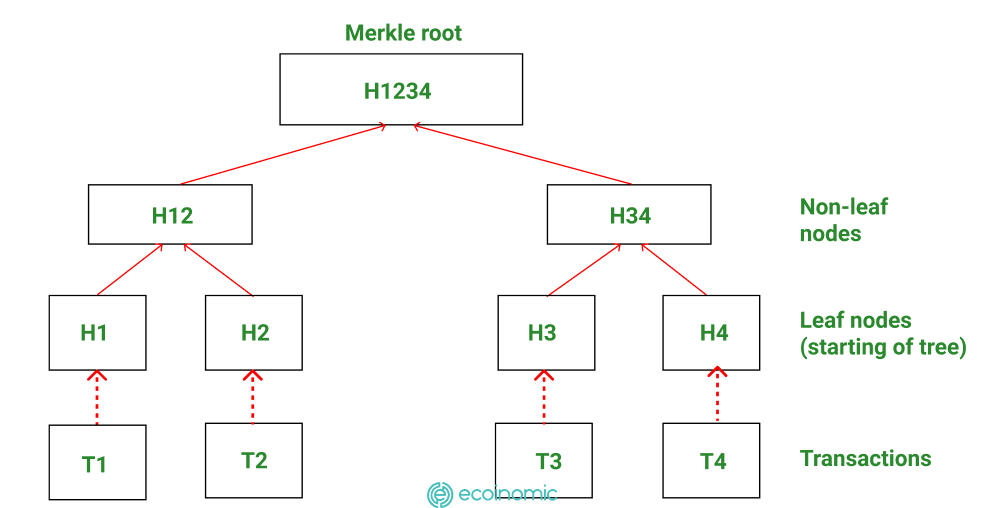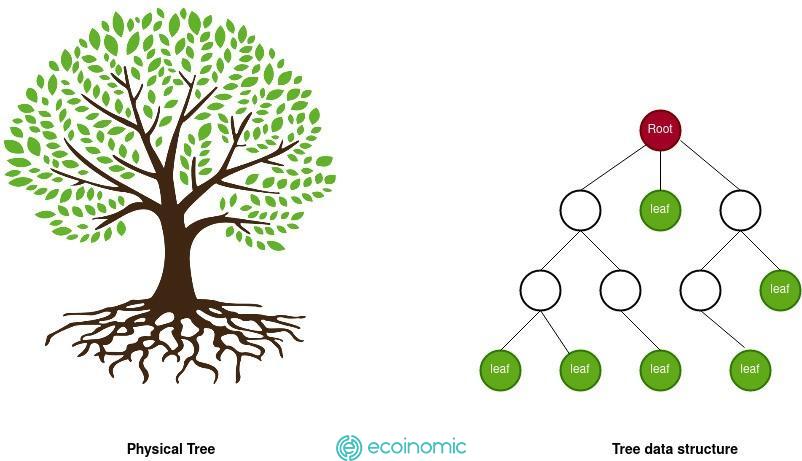Advertisement
In light of the increasingly strong development of the cryptocurrency and blockchain ecosystem, it is extremely necessary to learn about the technologies that power blockchain platforms. One of the important structures for maintaining the integrity of transactions is the merkle tree.
Merkle tree was proposed by scientist Ralph Merkle around 1980. Over the past 5 years, Merkle Tree has become popular and been widely used on platforms like Ethereum and Bitcoin.
In the following article, Ecoinomic.io will give you an overview of the activities and role of this structure in the blockchain network.
What is merkle tree?
Merkle tree or hash tree is a common data structure in cryptography and computer science to determine the integrity of data.
In the cryptocurrency market, merkle tree is made up of hashes of various data blocks. Merkle tree not only summarizes all transactions in a block but also allows verification of large datasets securely, quickly, ensuring data consistency.
Merkle tree is often used on P2P platform because the information is independently shared and validated. Change in the transaction data in the merkle tree system will cause a corresponding merkle root to be completely different. That makes it easier to check for changes or tampering of the data in the block.
>> Related: [Kickback rate 20%]: Guide to sign up for Binance account update 2022

Types of nodes in the merkle tree structure
The merkle tree structure consists of 3 nodes:
- Leaf node: includes hash values for transaction data. Every transaction in the block is encrypted by the hash function, which is then stored in leaf nodes.
- Non-leaf node: includes intermediate hash values used in the process from leaf-node to root-node.
- Root node: directly stores the last summarized data.
How does merkle tree work?
Merkle tree can be divided into small pieces of data for verification. After that, transactions are combined together in pairs. Each pair has a computational hash function that is stored directly in nodes. These nodes are connected in pairs, then their hash functions are stored at the next level.
The process of connecting these hash values repeats until the final hash value is generated. The final hash value provides a summary of all transactions in the block.
Suppose that a block consists of four transactions T1, T2, T3, T4. Each transaction is hashed before being stored directly on the leaf node as H1, H2, H3, H4.
The hashes are paired together, creating H12, H34 hashes. The merkle tree then combines these two hashes to form the H1234 hash called merkle root, which is responsible for summarizing and storing the data contained in specific transactions.
This process can be used with extended data sets.

Benefits of merkle tree
Merkle tree plays an important role in the cryptocurrency ecosystem, especially Bitcoin:
-
Validate data integrity
Any change in the order of transactions or the detailed content of each individual transaction is reflected in the hash of that transaction. That will change the value of merkle root and invalidate the block.
The data in the merkle tree is sorted down to make it easier to verify that allows checking whether a particular transaction is in the aggregate or not in a quick and simple way.
-
Economize memory
A cryptocurrency transaction executed according to the merkle tree structure will be hashed that gives an equivalent hash value. After that, the hash values will be paired in pairs, the process continues to repeat until the final hash is generated to summarize the data in a block.
When transmitting information over networks, merkle tree only requires a small amount of information, so it takes up less space than other data structures.
-
Fast verification speeds
The process of formatting and verifying the integrity of the data takes only a few minutes.
>>> Related: What is IPFS? The future of IPFS in blockchain
The role of merkle tree in blockchain development
Blockchain technology consists of thousands of different separate blocks, each of which can store data for thousands of different transactions. With a large number of transactions stored on a single block, handling requirements of computing power and memory capacity can be a major challenge.

Merkle tree is designed to break down large pieces of data into smaller parts, ensuring that all transactions can be verified in a timely manner. Merkle tree summarizes transactions, making it easy for users to verify the availability of transactions in a block.
Merkle tree allows transactions to be verified without using a lot of data which reduces the speed of the CPU while facilitating enhanced security.
Conclusion
Merkle tree plays an important role in computer science applications in general and in the blockchain ecosystem in particular. It not only offers the optimal solution to validate the integrity of the data but also makes the verification process quick, consuming less storage space.
Hopefully, the above article has given you an overview of merkle tree and the potential application of this structure on the blockchain platform.
















